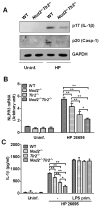The Cag pathogenicity island and interaction between TLR2/NOD2 and NLRP3 regulate IL-1β production in Helicobacter pylori infected dendritic cells
- PMID: 23818043
- PMCID: PMC3797179
- DOI: 10.1002/eji.201243281
The Cag pathogenicity island and interaction between TLR2/NOD2 and NLRP3 regulate IL-1β production in Helicobacter pylori infected dendritic cells
Erratum in
- Eur J Immunol. 2014 Jul;44(7):2197
Abstract
Helicobacter pylori colonization of the stomach affects about half of the world population and is associated with the development of gastritis, ulcers, and cancer. Polymorphisms in the IL1B gene are linked to an increased risk of H. pylori associated cancer, but the bacterial and host factors that regulate interleukin (IL)-1β production in response to H. pylori infection remain unknown. Using murine BM-derived DCs, we show that the bacterial virulence factors cytotoxin-associated genes pathogenicity island and CagL, but not vacuolating cytotoxin A or CagA, regulate the induction of pro-IL-1β and the production of mature IL-1β in response to H. pylori infection. We further show that the host receptors, Toll-like receptor 2 (TLR2) and nucleotide-binding oligomerization domain 2 (NOD2), but not NOD1, are required for induction of pro-IL-1β and NOD-like receptor pyrin domain containing 3 (NLRP3) in H. pylori infected DCs. In contrast, NLRP3 and the adaptor ASC were essential for the activation of caspase-1, processing of pro-IL-1β into IL-1β, and IL-1β secretion. Finally, we show that mice deficient in caspase-1, IL-1β, and IL-1 receptor, but not NLRP3, are impaired in the clearance of CagA-positive H. pylori from the stomach when compared with WT mice. These studies identify bacterial cag pathogenicity island and the cooperative interaction among host innate receptors TLR2, NOD2, and NLRP3 as important regulators of IL-1β production in H. pylori infected DCs.
Keywords: Helicobacter pylori; IL-1β; Inflammasome; NLRP3; NOD2.
© 2013 WILEY-VCH Verlag GmbH & Co. KGaA, Weinheim.
Figures






Similar articles
-
Unveiling the Crucial Role of Type IV Secretion System and Motility of Helicobacter pylori in IL-1β Production via NLRP3 Inflammasome Activation in Neutrophils.Front Immunol. 2020 Jun 9;11:1121. doi: 10.3389/fimmu.2020.01121. eCollection 2020. Front Immunol. 2020. PMID: 32582201 Free PMC article.
-
Helicobacter pylori-induced IL-1β secretion in innate immune cells is regulated by the NLRP3 inflammasome and requires the cag pathogenicity island.J Immunol. 2014 Oct 1;193(7):3566-76. doi: 10.4049/jimmunol.1400362. Epub 2014 Aug 29. J Immunol. 2014. PMID: 25172489 Clinical Trial.
-
Helicobacter urease-induced activation of the TLR2/NLRP3/IL-18 axis protects against asthma.J Clin Invest. 2015 Aug 3;125(8):3297-302. doi: 10.1172/JCI79337. Epub 2015 Jul 27. J Clin Invest. 2015. PMID: 26214524 Free PMC article.
-
Helicobacter pylori activates the TLR2/NLRP3/caspase-1/IL-18 axis to induce regulatory T-cells, establish persistent infection and promote tolerance to allergens.Gut Microbes. 2015;6(6):382-7. doi: 10.1080/19490976.2015.1105427. Gut Microbes. 2015. PMID: 26727421 Free PMC article. Review.
-
Inflammasome Activation by Helicobacter pylori and Its Implications for Persistence and Immunity.Curr Top Microbiol Immunol. 2016;397:117-31. doi: 10.1007/978-3-319-41171-2_6. Curr Top Microbiol Immunol. 2016. PMID: 27460807 Review.
Cited by
-
Evasion and interference: intracellular pathogens modulate caspase-dependent inflammatory responses.Nat Rev Microbiol. 2016 Jun;14(6):346-59. doi: 10.1038/nrmicro.2016.50. Epub 2016 May 13. Nat Rev Microbiol. 2016. PMID: 27174147 Review.
-
How does Helicobacter pylori cause gastric cancer through connexins: An opinion review.World J Gastroenterol. 2019 Sep 21;25(35):5220-5232. doi: 10.3748/wjg.v25.i35.5220. World J Gastroenterol. 2019. PMID: 31558869 Free PMC article. Review.
-
Withaferin A Inhibits Helicobacter pylori-induced Production of IL-1β in Dendritic Cells by Regulating NF-κB and NLRP3 Inflammasome Activation.Immune Netw. 2015 Dec;15(6):269-77. doi: 10.4110/in.2015.15.6.269. Epub 2015 Dec 24. Immune Netw. 2015. PMID: 26770181 Free PMC article.
-
Unveiling the Crucial Role of Type IV Secretion System and Motility of Helicobacter pylori in IL-1β Production via NLRP3 Inflammasome Activation in Neutrophils.Front Immunol. 2020 Jun 9;11:1121. doi: 10.3389/fimmu.2020.01121. eCollection 2020. Front Immunol. 2020. PMID: 32582201 Free PMC article.
-
An Overview of Helicobacter pylori Infection.Methods Mol Biol. 2021;2283:1-14. doi: 10.1007/978-1-0716-1302-3_1. Methods Mol Biol. 2021. PMID: 33765303 Review.
References
-
- Kawai T, Akira S. The role of pattern-recognition receptors in innate immunity: update on Toll-like receptors. Nat Immunol. 2010;11:373–384. - PubMed
-
- Kanneganti TD, Lamkanfi M, Núñez G. Intracellular NOD-like Receptors in Host Defense and Disease. Immunity. 2007;27:549–559. - PubMed
-
- Chamaillard M, Hashimoto M, Horie Y, Masumoto J, Qiu S, Saab L, Ogura Y, et al. An essential role for NOD1 in host recognition of bacterial peptidoglycan containing diaminopimelic acid. Nat Immunol. 2003;4:702–707. - PubMed
-
- Girardin SE, Boneca IG, Carneiro LAM, Antignac A, Jéhanno M, Viala J, Tedin K, et al. Nod1 Detects a Unique Muropeptide from Gram-Negative Bacterial Peptidoglycan. Science. 2003;300:1584–1587. - PubMed
-
- Girardin SE, Boneca IG, Viala J, Chamaillard M, Labigne A, Thomas G, Philpott DJ, et al. Nod2 Is a General Sensor of Peptidoglycan through Muramyl Dipeptide (MDP) Detection. J Biol Chem. 2003;278:8869–8872. - PubMed
Publication types
MeSH terms
Substances
Grants and funding
LinkOut - more resources
Full Text Sources
Other Literature Sources
Medical
Molecular Biology Databases
Miscellaneous

